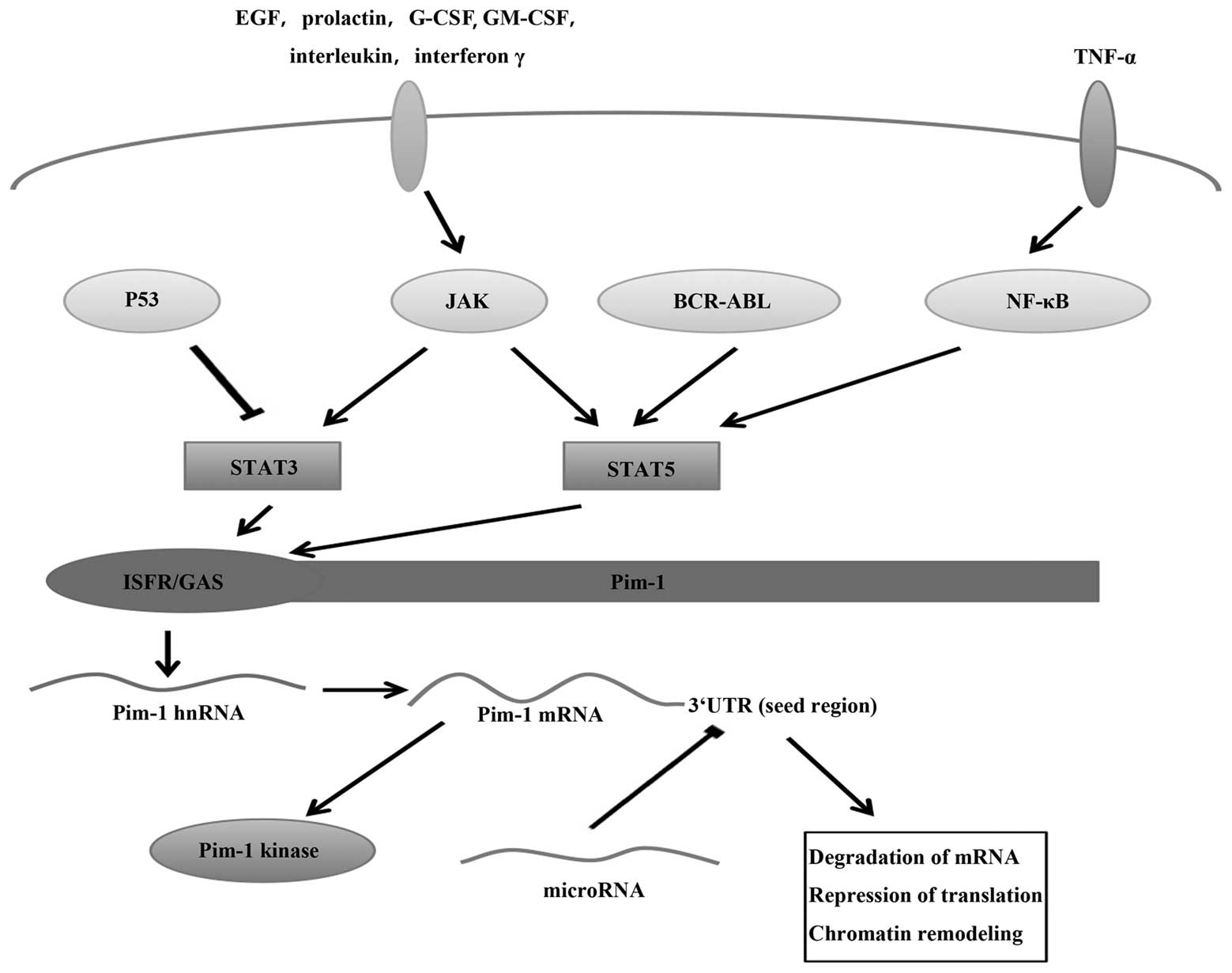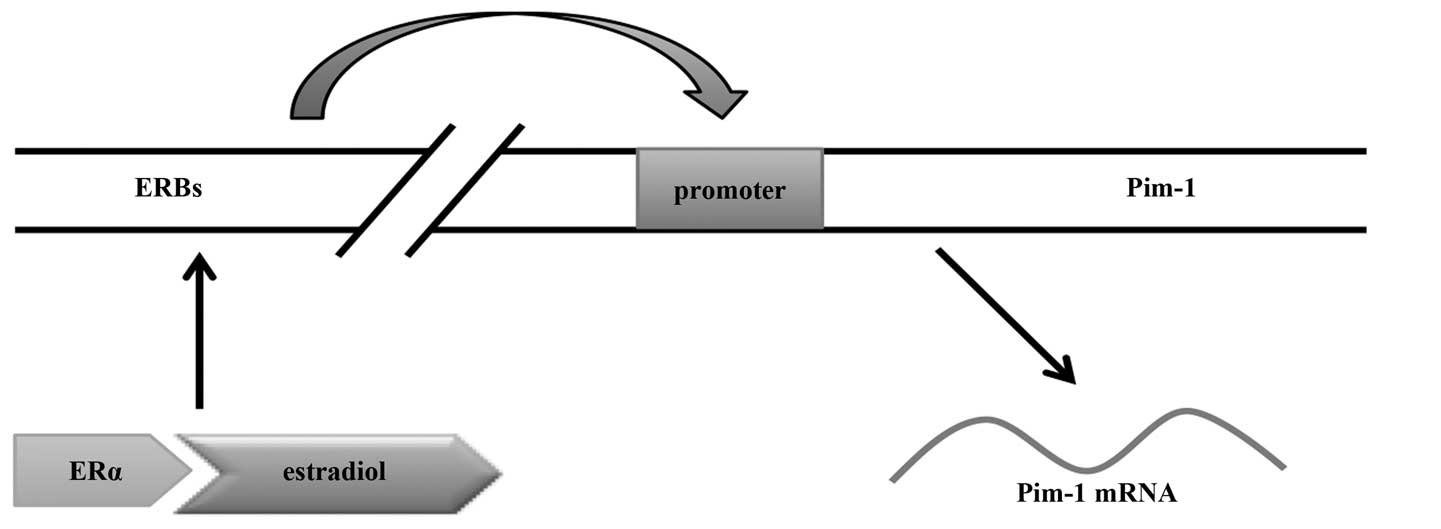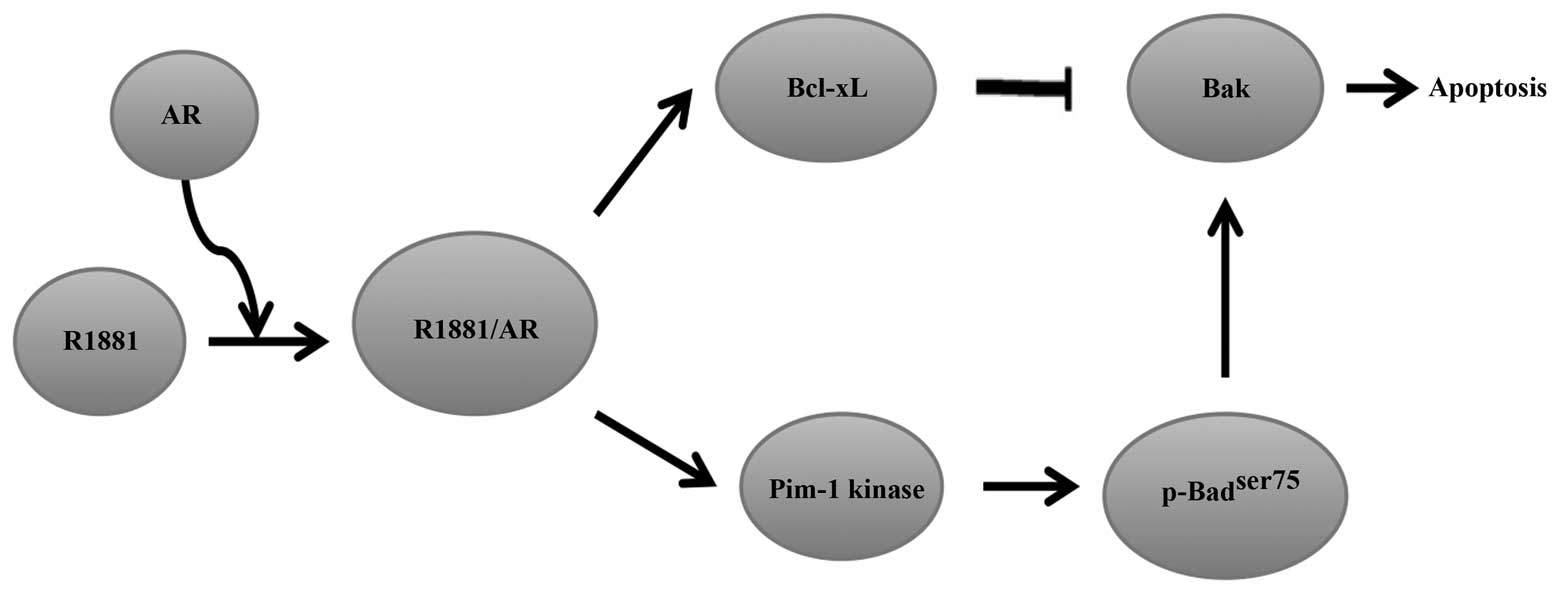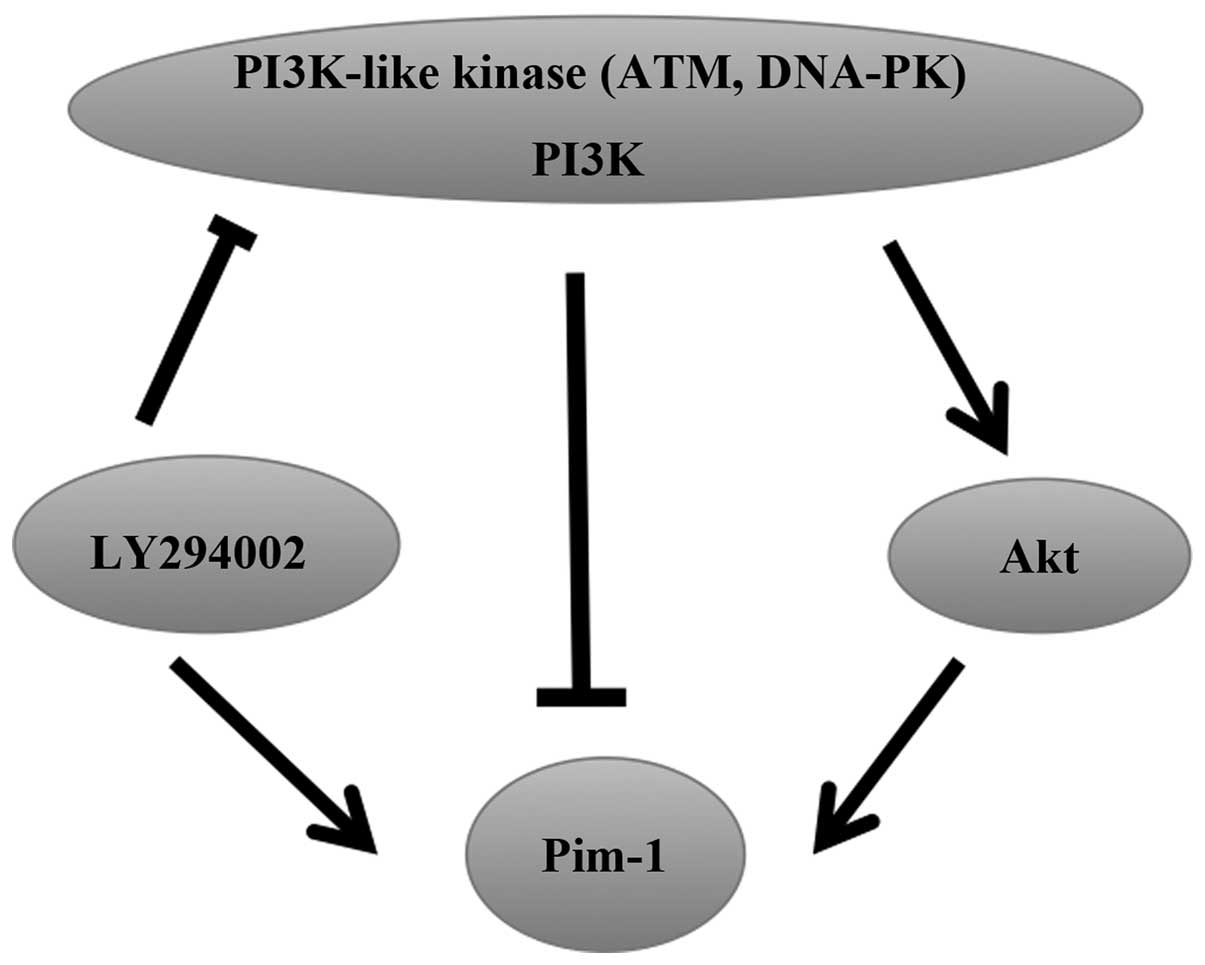|
1
|
Cuypers HT, Selten G, Quint W, et al:
Murine leukemia virus-induced T-cell lymphomagenesis: integration
of proviruses in a distinct chromosomal region. Cell. 37:141–150.
1984. View Article : Google Scholar : PubMed/NCBI
|
|
2
|
Bachmann M and Möröy T: The
serine/threonine kinase Pim-1. Int J Biochem Cell Biol. 37:726–730.
2005. View Article : Google Scholar : PubMed/NCBI
|
|
3
|
Mikkers H, Nawijn M, Allen J, et al: Mice
deficient for all PIM kinases display reduced body size and
impaired responses to hematopoietic growth factors. Mol Cell Biol.
24:6104–6115. 2004. View Article : Google Scholar : PubMed/NCBI
|
|
4
|
Selten G, Cuypers HT, Boelens W, et al:
The primary structure of the putative oncogene pim-1 shows
extensive homology with protein kinases. Cell. 46:603–611. 1986.
View Article : Google Scholar : PubMed/NCBI
|
|
5
|
Macdonald A, Campbell DG, Toth R,
McLauchlan H, Hastie CJ and Arthur JS: Pim kinases phosphorylate
multiple sites on Bad and promote 14-3-3 binding and dissociation
from Bcl-XL. BMC Cell Biol. 7:12006. View Article : Google Scholar : PubMed/NCBI
|
|
6
|
Saris CJ, Domen J and Berns A: The pim-1
oncogene encodes two related protein-serine/threonine kinases by
alternative initiation at AUG and CUG. EMBO J. 10:655–664.
1991.PubMed/NCBI
|
|
7
|
Morishita D, Katayama R, Sekimizu K,
Tsuruo T and Fujita N: Pim kinases promote cell cycle progression
by phosphorylating and down-regulating p27Kip1 at the
transcriptional and posttranscriptional levels. Cancer Res.
68:5076–5085. 2008. View Article : Google Scholar : PubMed/NCBI
|
|
8
|
Reeves R, Spies GA, Kiefer M, Barr PJ and
Power M: Primary structure of the putative human oncogene, pim-1.
Gene. 90:303–307. 1990. View Article : Google Scholar : PubMed/NCBI
|
|
9
|
Qian KC, Wang L, Hickey ER, et al:
Structural basis of constitutive activity and a unique nucleotide
binding mode of human Pim-1 kinase. J Biol Chem. 280:6130–6137.
2005. View Article : Google Scholar : PubMed/NCBI
|
|
10
|
Nawijn MC, Alendar A and Berns A: For
better or for worse: the role of Pim oncogenes in tumorigenesis.
Nat Rev Cancer. 11:23–34. 2011. View Article : Google Scholar : PubMed/NCBI
|
|
11
|
Bullock AN, Debreczeni J, Amos AL, Knapp S
and Turk BE: Structure and substrate specificity of the Pim-1
kinase. J Biol Chem. 280:41675–41682. 2005. View Article : Google Scholar : PubMed/NCBI
|
|
12
|
Mukaida N, Wang YY and Li YY: Roles of
Pim-3, a novel survival kinase, in tumorigenesis. Cancer Sci.
102:1437–1442. 2011. View Article : Google Scholar : PubMed/NCBI
|
|
13
|
Mochizuki T, Kitanaka C, Noguchi K,
Muramatsu T, Asai A and Kuchino Y: Physical and functional
interactions between Pim-1 kinase and Cdc25A phosphatase.
Implications for the Pim-1-mediated activation of the c-Myc
signaling pathway. J Biol Chem. 274:18659–18666. 1999. View Article : Google Scholar : PubMed/NCBI
|
|
14
|
Wang Z, Bhattacharya N, Mixter PF, Wei W,
Sedivy J and Magnuson NS: Phosphorylation of the cell cycle
inhibitor p21Cip1/WAF1 by Pim-1 kinase. Biochim Biophys Acta.
1593:45–55. 2002. View Article : Google Scholar : PubMed/NCBI
|
|
15
|
Bachmann M, Hennemann H, Xing PX, Hoffmann
I and Möröy T: The oncogenic serine/threonine kinase Pim-1
phosphorylates and inhibits the activity of Cdc25C-associated
kinase 1 (C-TAK1): a novel role for Pim-1 at the G2/M cell cycle
checkpoint. J Biol Chem. 279:48319–48328. 2004. View Article : Google Scholar : PubMed/NCBI
|
|
16
|
Bachmann M, Kosan C, Xing PX, Montenarh M,
Hoffmann I and Möröy T: The oncogenic serine/threonine kinase Pim-1
directly phosphorylates and activates the G2/M specific phosphatase
Cdc25C. Int J Biochem Cell Biol. 38:430–443. 2006. View Article : Google Scholar : PubMed/NCBI
|
|
17
|
Nosaka T and Kitamura T: Pim-1 expression
is sufficient to induce cytokine independence in murine
hematopoietic cells, but is dispensable for BCR-ABL-mediated
transformation. Exp Hematol. 30:697–702. 2002. View Article : Google Scholar : PubMed/NCBI
|
|
18
|
Brault L, Gasser C, Bracher F, Huber K,
Knapp S and Schwaller J: PIM serine/threonine kinases in the
pathogenesis and therapy of hematologic malignancies and solid
cancers. Haematologica. 95:1004–1015. 2010. View Article : Google Scholar : PubMed/NCBI
|
|
19
|
Esquela-Kerscher A and Slack FJ: Oncomirs
- microRNAs with a role in cancer. Nat Rev Cancer. 6:259–269. 2006.
View Article : Google Scholar
|
|
20
|
Calin GA and Croce CM: MicroRNA signatures
in human cancers. Nat Rev Cancer. 6:857–866. 2006. View Article : Google Scholar : PubMed/NCBI
|
|
21
|
Calin GA and Croce CM: MicroRNA-cancer
connection: the beginning of a new tale. Cancer Res. 66:7390–7394.
2006. View Article : Google Scholar : PubMed/NCBI
|
|
22
|
Thomas M, Lange-Grünweller K, Weirauch U,
et al: The proto-oncogene Pim-1 is a target of miR-33a. Oncogene.
31:918–928. 2012. View Article : Google Scholar : PubMed/NCBI
|
|
23
|
Lewis BP, Burge CB and Bartel DP:
Conserved seed pairing, often flanked by adenosines, indicates that
thousands of human genes are microRNA targets. Cell. 120:15–20.
2005. View Article : Google Scholar : PubMed/NCBI
|
|
24
|
Grimson A, Farh KK, Johnston WK,
Garrett-Engele P, Lim LP and Bartel DP: MicroRNA targeting
specificity in mammals: determinants beyond seed pairing. Mol Cell.
27:91–105. 2007. View Article : Google Scholar : PubMed/NCBI
|
|
25
|
Cimmino A, Calin GA, Fabbri M, et al:
miR-15 and miR-16 induce apoptosis by targeting BCL2. Proc Natl
Acad Sci USA. 102:13944–13949. 2005. View Article : Google Scholar : PubMed/NCBI
|
|
26
|
Calin GA, Dumitru CD, Shimizu M, et al:
Frequent deletions and down-regulation of micro- RNA genes miR15
and miR16 at 13q14 in chronic lymphocytic leukemia. Proc Natl Acad
Sci USA. 99:15524–15529. 2002. View Article : Google Scholar : PubMed/NCBI
|
|
27
|
Bonci D, Coppola V, Musumeci M, et al: The
miR-15a-miR-16-1 cluster controls prostate cancer by targeting
multiple oncogenic activities. Nat Med. 14:1271–1277. 2008.
View Article : Google Scholar : PubMed/NCBI
|
|
28
|
Birg F, Courcoul M, Rosnet O, et al:
Expression of the FMS/KIT-like gene FLT3 in human acute leukemias
of the myeloid and lymphoid lineages. Blood. 80:2584–2593.
1992.PubMed/NCBI
|
|
29
|
Nakao M, Yokota S, Iwai T, et al: Internal
tandem duplication of the flt3 gene found in acute myeloid
leukemia. Leukemia. 10:1911–1918. 1996.PubMed/NCBI
|
|
30
|
Yokota S, Kiyoi H, Nakao M, et al:
Internal tandem duplication of the FLT3 gene is preferentially seen
in acute myeloid leukemia and myelodysplastic syndrome among
various hematological malignancies. A study on a large series of
patients and cell lines. Leukemia. 11:1605–1609. 1997. View Article : Google Scholar
|
|
31
|
Thiede C, Steudel C, Mohr B, et al:
Analysis of FLT3-activating mutations in 979 patients with acute
myelogenous leukemia: association with FAB subtypes and
identification of subgroups with poor prognosis. Blood.
99:4326–4335. 2002. View Article : Google Scholar : PubMed/NCBI
|
|
32
|
Kim KT, Baird K, Ahn JY, et al: Pim-1 is
up-regulated by constitutively activated FLT3 and plays a role in
FLT3-mediated cell survival. Blood. 105:1759–1767. 2005. View Article : Google Scholar : PubMed/NCBI
|
|
33
|
Kim KT, Baird K, Davis S, et al:
Constitutive Fms-like tyrosine kinase 3 activation results in
specific changes in gene expression in myeloid leukaemic cells. Br
J Haematol. 138:603–615. 2007. View Article : Google Scholar : PubMed/NCBI
|
|
34
|
Kim KT, Carroll AP, Mashkani B, Cairns MJ,
Small D and Scott RJ: MicroRNA-16 is down-regulated in mutated FLT3
expressing murine myeloid FDC-P1 cells and interacts with Pim-1.
PLoS One. 7:e445462012. View Article : Google Scholar : PubMed/NCBI
|
|
35
|
Mizuki M, Fenski R, Halfter H, et al: Flt3
mutations from patients with acute myeloid leukemia induce
transformation of 32D cells mediated by the Ras and STAT5 pathways.
Blood. 96:3907–3914. 2000.
|
|
36
|
Tse KF, Mukherjee G and Small D:
Constitutive activation of FLT3 stimulates multiple intracellular
signal transducers and results in transformation. Leukemia.
14:1766–1776. 2000. View Article : Google Scholar : PubMed/NCBI
|
|
37
|
Hayakawa F, Towatari M, Kiyoi H, et al:
Tandem-duplicated Flt3 constitutively activates STAT5 and MAP
kinase and introduces autonomous cell growth in IL-3-dependent cell
lines. Oncogene. 19:624–631. 2000. View Article : Google Scholar : PubMed/NCBI
|
|
38
|
Nosaka T, Kawashima T, Misawa K, Ikuta K,
Mui AL and Kitamura T: STAT5 as a molecular regulator of
proliferation, differentiation and apoptosis in hematopoietic
cells. EMBO J. 18:4754–4765. 1999. View Article : Google Scholar : PubMed/NCBI
|
|
39
|
Rayner KJ, Suárez Y, Dávalos A, et al:
MiR-33 contributes to the regulation of cholesterol homeostasis.
Science. 328:1570–1573. 2010. View Article : Google Scholar : PubMed/NCBI
|
|
40
|
Tian Z, Zhao JJ, Tai YT, et al:
Investigational agent MLN9708/2238 targets tumor-suppressor miR33b
in MM cells. Blood. 120:3958–3967. 2012. View Article : Google Scholar : PubMed/NCBI
|
|
41
|
Ibrahim AF, Weirauch U, Thomas M,
Grünweller A, Hartmann RK and Aigner A: MicroRNA replacement
therapy for miR-145 and miR-33a is efficacious in a model of colon
carcinoma. Cancer Res. 71:5214–5224. 2011. View Article : Google Scholar : PubMed/NCBI
|
|
42
|
Chen JF, Mandel EM, Thomson JM, et al: The
role of microRNA-1 and microRNA-133 in skeletal muscle
proliferation and differentiation. Nat Genet. 38:228–233. 2006.
View Article : Google Scholar : PubMed/NCBI
|
|
43
|
Zhao Y, Ransom JF, Li A, et al:
Dysregulation of cardiogenesis, cardiac conduction, and cell cycle
in mice lacking miRNA-1-2. Cell. 129:303–317. 2007. View Article : Google Scholar : PubMed/NCBI
|
|
44
|
Katakami N, Kaneto H, Hao H, et al: Role
of pim-1 in smooth muscle cell proliferation. J Biol Chem.
279:54742–54749. 2004. View Article : Google Scholar : PubMed/NCBI
|
|
45
|
Chen J, Yin H, Jiang Y, et al: Induction
of microRNA-1 by myocardin in smooth muscle cells inhibits cell
proliferation. Arterioscler Thromb Vasc Biol. 31:368–375. 2011.
View Article : Google Scholar : PubMed/NCBI
|
|
46
|
Katare RG, Caporali A, Oikawa A, Meloni M,
Emanueli C and Madeddu P: Vitamin B1 analog benfotiamine prevents
diabetes-induced diastolic dysfunction and heart failure through
Akt/Pim-1-mediated survival pathway. Circ Heart Fail. 3:294–305.
2010. View Article : Google Scholar
|
|
47
|
Katare R, Caporali A, Zentilin L, et al:
Intravenous gene therapy with PIM-1 via a cardiotropic viral vector
halts the progression of diabetic cardiomyopathy through promotion
of prosurvival signaling. Circ Res. 108:1238–1251. 2011. View Article : Google Scholar : PubMed/NCBI
|
|
48
|
Mishima T, Mizuguchi Y, Kawahigashi Y and
Takizawa T and Takizawa T: RT-PCR-based analysis of microRNA (miR-1
and -124) expression in mouse CNS. Brain Res. 1131:37–43. 2007.
View Article : Google Scholar : PubMed/NCBI
|
|
49
|
Sevignani C, Calin GA, Nnadi SC, et al:
MicroRNA genes are frequently located near mouse cancer
susceptibility loci. Proc Natl Acad Sci USA. 104:8017–8022. 2007.
View Article : Google Scholar : PubMed/NCBI
|
|
50
|
Nasser MW, Datta J, Nuovo G, et al:
Down-regulation of micro-RNA-1 (miR-1) in lung cancer. Suppression
of tumorigenic property of lung cancer cells and their
sensitization to doxorubicin-induced apoptosis by miR-1. J Biol
Chem. 283:33394–33405. 2008. View Article : Google Scholar : PubMed/NCBI
|
|
51
|
Jin Y, Tong DY, Chen JN, et al:
Overexpression of osteopontin, αvβ3 and Pim-1 associated with
prognostically important clinicopathologic variables in non-small
cell lung cancer. PloS One. 7:e485752012.
|
|
52
|
Nieborowska-Skorska M, Hoser G, Kossev P,
Wasik MA and Skorski T: Complementary functions of the
antiapoptotic protein A1 and serine/threonine kinase pim-1 in the
BCR/ABL-mediated leukemogenesis. Blood. 99:4531–4539. 2002.
View Article : Google Scholar : PubMed/NCBI
|
|
53
|
Eiring AM, Harb JG, Neviani P, et al:
miR-328 functions as an RNA decoy to modulate hnRNP E2 regulation
of mRNA translation in leukemic blasts. Cell. 140:652–665. 2010.
View Article : Google Scholar : PubMed/NCBI
|
|
54
|
Kulshreshtha R, Ferracin M, Wojcik SE, et
al: A microRNA signature of hypoxia. Mol Cell Biol. 27:1859–1867.
2007. View Article : Google Scholar
|
|
55
|
Camps C, Buffa FM, Colella S, et al:
hsa-miR-210 Is induced by hypoxia and is an independent prognostic
factor in breast cancer. Clin Cancer Res. 14:1340–1348. 2008.
View Article : Google Scholar : PubMed/NCBI
|
|
56
|
Huang X, Ding L, Bennewith KL, et al:
Hypoxia-inducible mir-210 regulates normoxic gene expression
involved in tumor initiation. Mol Cell. 35:856–867. 2009.
View Article : Google Scholar : PubMed/NCBI
|
|
57
|
Kelsey JL: Breast cancer epidemiology:
summary and future directions. Epidemiol Rev. 15:256–263.
1993.PubMed/NCBI
|
|
58
|
Horimoto Y, Hartman J, Millour J, et al:
ERβ1 represses FOXM1 expression through targeting ERα to control
cell proliferation in breast cancer. Am J Pathol. 179:1148–1156.
2011.
|
|
59
|
Malinen M, Jääskeläinen T, Pelkonen M, et
al: Proto-oncogene PIM-1 is a novel estrogen receptor target
associating with high grade breast tumors. Mol Cell Endocrinol.
365:270–276. 2013. View Article : Google Scholar : PubMed/NCBI
|
|
60
|
Dumas de la Roque E, Savineau JP and
Bonnet S: Dehydroepiandrosterone: A new treatment for vascular
remodeling diseases including pulmonary arterial hypertension.
Pharmacol Ther. 126:186–199. 2010.PubMed/NCBI
|
|
61
|
Paulin R, Meloche J, Jacob MH, Bisserier
M, Courboulin A and Bonnet S: Dehydroepiandrosterone inhibits the
Src/STAT3 constitutive activation in pulmonary arterial
hypertension. Am J Physiol Heart Circ Physiol. 301:H1798–H1809.
2011. View Article : Google Scholar : PubMed/NCBI
|
|
62
|
Dhanasekaran SM, Barrette TR, Ghosh D, et
al: Delineation of prognostic biomarkers in prostate cancer.
Nature. 412:822–826. 2001. View Article : Google Scholar : PubMed/NCBI
|
|
63
|
Guzey M, Kitada S and Reed JC: Apoptosis
induction by 1alpha,25-dihydroxyvitamin D3 in prostate cancer. Mol
Cancer Ther. 1:667–677. 2002.PubMed/NCBI
|
|
64
|
Okamoto R, Delansorne R, Wakimoto N, et
al: Inecalcitol, an analog of 1α,25(OH)(2) D(3), induces growth
arrest of androgen-dependent prostate cancer cells. Int J Cancer.
130:2464–2473. 2012.
|
|
65
|
Ha S, Iqbal NJ, Mita P, et al:
Phosphorylation of the androgen receptor by PIM1 in hormone
refractory prostate cancer. Oncogene. 32:3992–4000. 2013.
View Article : Google Scholar : PubMed/NCBI
|
|
66
|
Maier CJ, Maier RH, Rid R, et al: PIM-1
kinase interacts with the DNA binding domain of the vitamin D
receptor: a further kinase implicated in 1,25-(OH)2D3 signaling.
BMC Mol Biol. 13:182012. View Article : Google Scholar : PubMed/NCBI
|
|
67
|
Shand RL and Gelmann EP: Molecular biology
of prostate-cancer pathogenesis. Curr Opin Urol. 16:123–131. 2006.
View Article : Google Scholar : PubMed/NCBI
|
|
68
|
Roach M III: Current trends for the use of
androgen deprivation therapy in conjunction with radiotherapy for
patients with unfavorable intermediate-risk, high-risk, localized,
and locally advanced prostate cancer. Cancer. Mar 3–2014.(Epub
ahead of print).
|
|
69
|
Carson JP, Kulik G and Weber MJ:
Antiapoptotic signaling in LNCaP prostate cancer cells: a survival
signaling pathway independent of phosphatidylinositol 3′-kinase and
Akt/protein kinase B. Cancer Res. 59:1449–1453. 1999.
|
|
70
|
Sun A, Tang J, Hong Y, et al: Androgen
receptor-dependent regulation of Bcl-xL expression: Implication in
prostate cancer progression. Prostate. 68:453–461. 2008. View Article : Google Scholar : PubMed/NCBI
|
|
71
|
Kumar JK, Ping RY, Teong HF, Goh S and
Clément MV: Activation of a non-genomic Pim-1/Bad-Pser75 module is
required for an efficient pro-survival effect of Bcl-xL induced by
androgen in LNCaP cells. Int J Biochem Cell Biol. 43:594–603. 2011.
View Article : Google Scholar : PubMed/NCBI
|
|
72
|
Min X, Tang J, Wang Y, et al: PI3K-like
kinases restrain Pim gene expression in endothelial cells. J
Huazhong Univ Sci Technolog Med Sci. 32:17–23. 2012. View Article : Google Scholar : PubMed/NCBI
|
|
73
|
Muraski JA, Rota M, Misao Y, et al: Pim-1
regulates cardiomyocyte survival downstream of Akt. Nat Med.
13:1467–1475. 2007. View
Article : Google Scholar : PubMed/NCBI
|
|
74
|
Zippo A, De Robertis A, Bardelli M,
Galvagni F and Oliviero S: Identification of Flk-1 target genes in
vasculogenesis: Pim-1 is required for endothelial and mural cell
differentiation in vitro. Blood. 103:4536–4544. 2004. View Article : Google Scholar : PubMed/NCBI
|
|
75
|
Stout BA, Bates ME, Liu LY, Farrington NN
and Bertics PJ: IL-5 and granulocyte-macrophage colony-stimulating
factor activate STAT3 and STAT5 and promote Pim-1 and cyclin D3
protein expression in human eosinophils. J Immunol. 173:6409–6417.
2004. View Article : Google Scholar : PubMed/NCBI
|
|
76
|
Willert M, Augstein A, Poitz DM,
Schmeisser A, Strasser RH and Braun-Dullaeus RC: Transcriptional
regulation of Pim-1 kinase in vascular smooth muscle cells and its
role for proliferation. Basic Res Cardiol. 105:267–277. 2010.
View Article : Google Scholar : PubMed/NCBI
|
|
77
|
Block KM, Hanke NT, Maine EA and Baker AF:
IL-6 stimulates STAT3 and Pim-1 kinase in pancreatic cancer cell
lines. Pancreas. 41:773–781. 2012.PubMed/NCBI
|
|
78
|
Jacobs MD, Black J, Futer O, et al: Pim-1
ligand-bound structures reveal the mechanism of serine/threonine
kinase inhibition by LY294002. J Biol Chem. 280:13728–13734. 2005.
View Article : Google Scholar : PubMed/NCBI
|
|
79
|
Gavara L, Suchaud V, Nauton L, Théry V,
Anizon F and Moreau P: Identification of pyrrolo[2,3-g]indazoles as
new Pim kinase inhibitors. Bioorg Med Chem Lett. 23:2298–2301.
2013.
|
|
80
|
Blanco-Aparicio C and Carnero A: Pim
kinases in cancer: diagnostic, prognostic and treatment
opportunities. Biochem Pharmacol. 85:629–643. 2013. View Article : Google Scholar : PubMed/NCBI
|
|
81
|
Mumenthaler SM, Ng PY, Hodge A, et al:
Pharmacologic inhibition of Pim kinases alters prostate cancer cell
growth and resensitizes chemoresistant cells to taxanes. Mol Cancer
Ther. 8:2882–2893. 2009. View Article : Google Scholar : PubMed/NCBI
|
|
82
|
Chen LS, Redkar S, Taverna P, Cortes JE
and Gandhi V: Mechanisms of cytotoxicity to Pim kinase inhibitor,
SGI-1776, in acute myeloid leukemia. Blood. 118:693–702. 2011.
View Article : Google Scholar : PubMed/NCBI
|
|
83
|
Yang Q, Chen LS, Neelapu SS, Miranda RN,
Medeiros LJ and Gandhi V: Transcription and translation are primary
targets of Pim kinase inhibitor SGI-1776 in mantle cell lymphoma.
Blood. 120:3491–3500. 2012. View Article : Google Scholar : PubMed/NCBI
|
|
84
|
Batra V, Maris JM, Kang MH, et al: Initial
testing (stage 1) of SGI-1776, a PIM1 kinase inhibitor, by the
pediatric preclinical testing program. Pediatr Blood Cancer.
59:749–752. 2012. View Article : Google Scholar : PubMed/NCBI
|
|
85
|
Chen LS, Redkar S, Bearss D, Wierda WG and
Gandhi V: Pim kinase inhibitor, SGI-1776, induces apoptosis in
chronic lymphocytic leukemia cells. Blood. 114:4150–4157. 2009.
View Article : Google Scholar : PubMed/NCBI
|
|
86
|
Chang M, Kanwar N, Feng E, et al: PIM
kinase inhibitors downregulate STAT3(Tyr705) phosphorylation. Mol
Cancer Ther. 9:2478–2487. 2010. View Article : Google Scholar : PubMed/NCBI
|
|
87
|
Siu A, Virtanen C and Jongstra J: PIM
kinase isoform specific regulation of MIG6 expression and EGFR
signaling in prostate cancer cells. Oncotarget. 2:1134–1144.
2011.PubMed/NCBI
|
|
88
|
Xie Y, Burcu M, Linn DE, Qiu Y and Baer
MR: Pim-1 kinase protects P-glycoprotein from degradation and
enables its glycosylation and cell surface expression. Mol
Pharmacol. 78:310–318. 2010. View Article : Google Scholar : PubMed/NCBI
|
|
89
|
Natarajan K, Bhullar J, Shukla S, et al:
The Pim kinase inhibitor SGI-1776 decreases cell surface expression
of P-glycoprotein (ABCB1) and breast cancer resistance protein
(ABCG2) and drug transport by Pim-1-dependent and -independent
mechanisms. Biochem Pharmacol. 85:514–524. 2013. View Article : Google Scholar : PubMed/NCBI
|
|
90
|
Kelly KR, Espitia CM, Taverna P, et al:
Targeting PIM kinase activity significantly augments the efficacy
of cytarabine. Br J Haematol. 156:129–132. 2012. View Article : Google Scholar : PubMed/NCBI
|
|
91
|
Pogacic V, Bullock AN, Fedorov O, et al:
Structural analysis identifies imidazo[1,2-b]pyridazines as PIM
kinase inhibitors with in vitro antileukemic activity. Cancer Res.
67:6916–6924. 2007.PubMed/NCBI
|
|
92
|
Holder S, Zemskova M, Zhang C, et al:
Characterization of a potent and selective small-molecule inhibitor
of the PIM1 kinase. Mol Cancer Ther. 6:163–172. 2007. View Article : Google Scholar : PubMed/NCBI
|
|
93
|
Jie W, He QY, Luo BT, et al: Inhibition of
Pim-1 attenuates the proliferation and migration in nasopharyngeal
carcinoma cells. Asian Pac J Trop Med. 5:645–650. 2012. View Article : Google Scholar : PubMed/NCBI
|
|
94
|
Akué-Gédu R, Rossignol E, Azzaro S, et al:
Synthesis, kinase inhibitory potencies, and in vitro
antiproliferative evaluation of new Pim kinase inhibitors. J Med
Chem. 52:6369–6381. 2009.PubMed/NCBI
|
|
95
|
Santio NM, Vahakoski RL, Rainio EM, et al:
Pim-selective inhibitor DHPCC-9 reveals Pim kinases as potent
stimulators of cancer cell migration and invasion. Mol Cancer.
9:2792010. View Article : Google Scholar : PubMed/NCBI
|
|
96
|
Mori M, Tintori C, Christopher RS, et al:
A combination strategy to inhibit Pim-1: synergism between
noncompetitive and ATP-competitive inhibitors. ChemMedChem.
8:484–496. 2013. View Article : Google Scholar : PubMed/NCBI
|
|
97
|
Grundler R, Brault L, Gasser C, et al:
Dissection of PIM serine/threonine kinases in FLT3-ITD-induced
leukemogenesis reveals PIM1 as regulator of CXCL12-CXCR4-mediated
homing and migration. J Exp Med. 206:1957–1970. 2009. View Article : Google Scholar : PubMed/NCBI
|


















